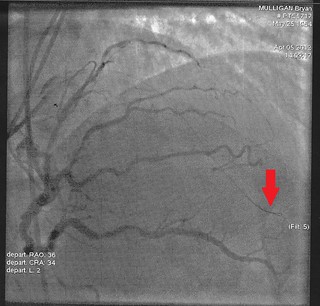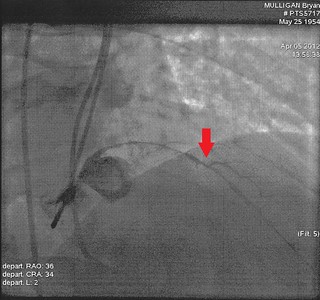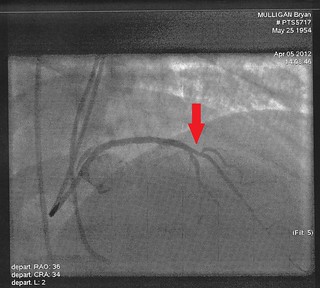Actually a lot of people. But perhaps, a more pertinent question is: Who DOESN'T care? And the answer to that is, clearly, the current tory government.
New Zealand has a Ministry of Consumer Affairs. According to it's website, "Our main role is to create an environment that promotes good and accurate information flows between suppliers and consumers so that consumers can transact with confidence."
So it deals with consumer protection and the setting of the ground-rules by which businesses interact with consumers.
In the current government's first term, the Minister was from National's support party, the ACT sideshow. Now the ACT Party draws its name from the initials of the 'Association of Consumers and Taxpayers', so appointing as Minister, ACT MP Heather Roy seemed a sensible ploy. After all, her party stands for the interests of consumers, doesn't it?
After ACT began to implode, John Boscawen, also from ACT, took up the reins in mid August 2010.
By mid June 2011, National had taken control of the Ministry, appointing Simon Power to head it. But, when, later in the year, he stepped aside from the political life he was replaced by Chris Tremain.
A further re-shuffle was necessitated by the resignation of Ministerial warrants by Nick Smith, which has meant the the Ministry of Consumer Affairs is now headed by Simon Bridges.
Bridges is a Minister Outside Cabinet. So if we assume Key has a core group who comprise a 'kitchen cabinet' or inner circle, that puts Consumer Affairs at 3 removes from real power and influence.
Add to that, the fact that there have been 5 different ministers within the last 20 months, and that 2 of them were from the government's 'support party' (read: stooges), and it is clear that this government's attitude is one of lip-service to the interests and protection of the rights of consumers.
The Ministerial writ has been used as a sop for flunkies, as a disposable bauble for a support party, as a reward for good behaviour, and as a training ground for up-and-coming junior MPs.
So, yes, we can say the National Government looks after the interests of Consumers. Yeah right!!
Tuesday, April 17, 2012
Monday, April 16, 2012
The Heart of the matter (5)
The last time I reported progress, I confidently claimed everything was "Done & dusted, … Bar the bruising." Too soon, apparently, and it's been an eventful few days since that last update!
The 2 Stents had been inserted successfully. By Sunday I was ready to make a gentle beginning to some exercise, so Desiree & I headed to Petone Beach for a stroll along the foreshore, followed by coffee at the Jetty Cafe. So far so good.
Unfortunately, I managed less than 200 metres before I had to call a stop. My right calf was in considerable pain, and I doubted I could make any further distance. So we called a halt, and Desiree went to get the car to collect me. We did go and have coffee and we talked about what to do next.
I dithered, of course, and tried to avoid (or at least delay) the inevitable, but by Sunday morning my calf was in pain even while I wasn't doing anything, action was required. A visit to the after hours centre resulted in a referral to the vascular team at Wellington Hospital. That meant a trip into town, an examination by the Registrar, and arrangements for a scan of the leg.
Turns out the Specialist also works at Southern Cross Hospital, and they could deal with me post haste. That meant I was to go in for an ultra-sound scan the next day (Tuesday). It transpired that what had happened was that a small device used to close the artery at the point through which entry was made to insert the stents, had come loose.
This small device (a collagen-based thing) is about half the size of a pea, but, after traveling into the artery in my leg, was big enough to block major branches of the artery in my lower right leg.
So another round of surgery was scheduled for that afternoon to have the blockage removed. The upshot is that I woke up to a sizable wound on my calf, and the prospect of a couple of days in hospital.
My movement was restricted to hobbling about on crutches, BUT - the first good news in a few days! - I was released in time to be at home to watch the Breakers win the first of their ANBL Finals. I spent the next few days popping pills, hobbling about, and keeping my leg elevated.
A followup visit to the vascular specialist told me that he's happy with the outcome of his work! The wounds are healing nicely and there haven't been any further complications. The problem at the moment is pain relief and mobility. I am having to keep doped up on Voltaren and Panadol, and am still struggling about on crutches, although at the good times, I'm down to a single crutch.
The specialist's advice was that I could drive and return to work 'when I felt able to'. At this stage that is likely to be a few days, given the extent to which I struggle to get started after periods of sitting or lying, and the need to keep my leg elevated when not walking. This last one will be difficult to accommodate in our office!
Touch wood, recovery and rehab is plain sailing from here on!
The 2 Stents had been inserted successfully. By Sunday I was ready to make a gentle beginning to some exercise, so Desiree & I headed to Petone Beach for a stroll along the foreshore, followed by coffee at the Jetty Cafe. So far so good.
Unfortunately, I managed less than 200 metres before I had to call a stop. My right calf was in considerable pain, and I doubted I could make any further distance. So we called a halt, and Desiree went to get the car to collect me. We did go and have coffee and we talked about what to do next.
I dithered, of course, and tried to avoid (or at least delay) the inevitable, but by Sunday morning my calf was in pain even while I wasn't doing anything, action was required. A visit to the after hours centre resulted in a referral to the vascular team at Wellington Hospital. That meant a trip into town, an examination by the Registrar, and arrangements for a scan of the leg.
Turns out the Specialist also works at Southern Cross Hospital, and they could deal with me post haste. That meant I was to go in for an ultra-sound scan the next day (Tuesday). It transpired that what had happened was that a small device used to close the artery at the point through which entry was made to insert the stents, had come loose.
This small device (a collagen-based thing) is about half the size of a pea, but, after traveling into the artery in my leg, was big enough to block major branches of the artery in my lower right leg.
So another round of surgery was scheduled for that afternoon to have the blockage removed. The upshot is that I woke up to a sizable wound on my calf, and the prospect of a couple of days in hospital.
My movement was restricted to hobbling about on crutches, BUT - the first good news in a few days! - I was released in time to be at home to watch the Breakers win the first of their ANBL Finals. I spent the next few days popping pills, hobbling about, and keeping my leg elevated.
A followup visit to the vascular specialist told me that he's happy with the outcome of his work! The wounds are healing nicely and there haven't been any further complications. The problem at the moment is pain relief and mobility. I am having to keep doped up on Voltaren and Panadol, and am still struggling about on crutches, although at the good times, I'm down to a single crutch.
The specialist's advice was that I could drive and return to work 'when I felt able to'. At this stage that is likely to be a few days, given the extent to which I struggle to get started after periods of sitting or lying, and the need to keep my leg elevated when not walking. This last one will be difficult to accommodate in our office!
Touch wood, recovery and rehab is plain sailing from here on!
The Ghoul's Gallery
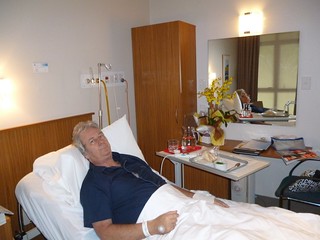

The leg in question, swathed in a 'compression sock' to help reduce the swelling

Rehab on the couch
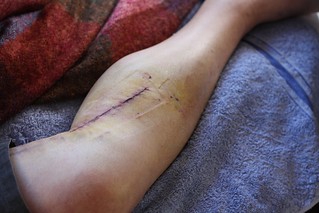
The scar and bruising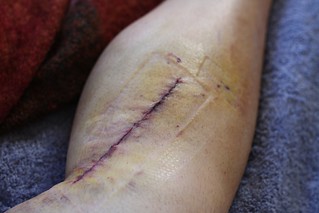
Sunday, April 8, 2012
Whatever happened to the Church of The Left?
Anthony Hubbard makes a striking claim in his Sunday Start-Times column on 8 April 2012. He says that "It's the God of the far Right that causes the trouble, and it is striking that Christian politics is so often of the Right."
That's a sentiment with which I find it difficult to disagree.
But it does raise an interesting question: Has it always been thus, at least in New Zealand?
And the answer has to be: No, it hasn't. And in fact one could argue that this phenomenon is only a relatively recent one.
You see New Zealand has quite a history of what in the nineteenth century was called 'muscular Christianity'. And if it didn't always have what could be called a liberal or left-leaning viewpoint, it was at least concerened with social action and social justice or progress.
To illustrate. Some of the earliest 'social welfare' legislation passed by the Liberal Government of the 1890s, was inspired by the preaching and social evangelism of Rev Rutherford Waddell, a Presbyterian Minister in Dunedin. He spoke out, famously, about the evils of 'sweated labour' - of the exploitation of workers, in other words.
Many of the middle-class Temperance campaigners from the same era were members of the Women's CHRISTIAN Temperance Movement, who sought to curb the sale of alcohol because of it's pernicious effects on the lives of women and children, especially in the working classes.
This same late-nineteenth century period also saw the rise in New Zealand of the Salvation Army with it's social action programmes.
These campaigners, and others like them weren't just outsiders, agitating for change. Their views were often echoed by, or inspired, the emerging 'party political' activist class which developed in the early twentieth century.
The Methodist Church's own website says"
There was a strong Christian presence in some of the union movement, and a number of prominent early Labour politicans had an explicit background in Christian organisations or affiliations. Michael Joseph Savage, Harry Holland, Peter Fraser, Walter Nash, and Arnold Nordmeyer all had clear ties to various churches. A number of Labour politicians were Conscientious Objectors during World War One.
Norman Kirk and then David Lange were later politicians whose political views were deeply informed by their religious upbringing and background.
So what's happened? The overwhelming impression presented by the Christian churches of the late twentieth- and early twent-first centuries is of, on the one hand, a focus on individual salvation, and, on the other, a wish to impose a narrow set of beliefs as the underpinning of social policy. Missing are the champions of social justice, a wish to reduce or reverse social inequality, and undo the perniciousness of modern social alienation and anomie.
It's hard to avoid noting the parallel with the decline or reduction in influence of the traditional 'British' segment of our society and the gradual 'Americanisation' of our society and especially economy. The replacement of the traditional mainstream Churches (Catholic, Anglican, Methodist, Presbytarian) with the newer, pentecostal-orentated churches like Arise and Destiny with their mimicry of US 'tele-vangelists' and contrived audience hysteria.
You wonder if Christ is spinning on his Cross.
That's a sentiment with which I find it difficult to disagree.
But it does raise an interesting question: Has it always been thus, at least in New Zealand?
And the answer has to be: No, it hasn't. And in fact one could argue that this phenomenon is only a relatively recent one.
You see New Zealand has quite a history of what in the nineteenth century was called 'muscular Christianity'. And if it didn't always have what could be called a liberal or left-leaning viewpoint, it was at least concerened with social action and social justice or progress.
To illustrate. Some of the earliest 'social welfare' legislation passed by the Liberal Government of the 1890s, was inspired by the preaching and social evangelism of Rev Rutherford Waddell, a Presbyterian Minister in Dunedin. He spoke out, famously, about the evils of 'sweated labour' - of the exploitation of workers, in other words.
Many of the middle-class Temperance campaigners from the same era were members of the Women's CHRISTIAN Temperance Movement, who sought to curb the sale of alcohol because of it's pernicious effects on the lives of women and children, especially in the working classes.
This same late-nineteenth century period also saw the rise in New Zealand of the Salvation Army with it's social action programmes.
These campaigners, and others like them weren't just outsiders, agitating for change. Their views were often echoed by, or inspired, the emerging 'party political' activist class which developed in the early twentieth century.
The Methodist Church's own website says"
"Some working-class Methodists sought to pursue the lessons of their faith through political action. The Methodist enthusiasm for egalitarianism, and for protecting the needy, found a voice in left-wing politics. Methodist missionary Colin Scrimgeour, known as Uncle Scrim, hosted ‘The friendly road’, a popular but controversial religious radio programme in the 1930s. In it he criticised the government and urged support for the Labour Party on humanitarian grounds."
There was a strong Christian presence in some of the union movement, and a number of prominent early Labour politicans had an explicit background in Christian organisations or affiliations. Michael Joseph Savage, Harry Holland, Peter Fraser, Walter Nash, and Arnold Nordmeyer all had clear ties to various churches. A number of Labour politicians were Conscientious Objectors during World War One.
Norman Kirk and then David Lange were later politicians whose political views were deeply informed by their religious upbringing and background.
So what's happened? The overwhelming impression presented by the Christian churches of the late twentieth- and early twent-first centuries is of, on the one hand, a focus on individual salvation, and, on the other, a wish to impose a narrow set of beliefs as the underpinning of social policy. Missing are the champions of social justice, a wish to reduce or reverse social inequality, and undo the perniciousness of modern social alienation and anomie.
It's hard to avoid noting the parallel with the decline or reduction in influence of the traditional 'British' segment of our society and the gradual 'Americanisation' of our society and especially economy. The replacement of the traditional mainstream Churches (Catholic, Anglican, Methodist, Presbytarian) with the newer, pentecostal-orentated churches like Arise and Destiny with their mimicry of US 'tele-vangelists' and contrived audience hysteria.
You wonder if Christ is spinning on his Cross.
Saturday, April 7, 2012
The Heart of the Matter (4)
Well, that's that, then! Done & dusted, as it were. Bar the bruising.
Thursday I was scheduled for my Angioplasty "procedure" (apparently not an "operation"). In other words I was to be 'blown up' in order to open a blocked artery near my heart. Sounds straight-forward doesn't it. And in theory it is.
Only there can be difficulties or complications. And maybe I'm related to that fellow Murphy, because my angioplasty wasn't straight-forward.
This is a 'before' picture:
You can see the 'wire' which was inserted. They start with one about the width of a human hair! The one arrowed in the picture has a loop at the end. It is in an artery but there is no blood or width, because it's blocked of course.
The first difficulty the surgeon had was that the blockage was resistant - he had difficulty getting the wire to penetrate it, perhaps because it had been there a while and had solidified. So that called for a variety of wire thicknesses and endpoints.
But this next picture shows that the blockage has been penetrated but not yet enlarged, hence you can see the artery, but it is still very narrow.
But then, having managed to penetrate it, he then had difficulty getting the balloon inflated. They had to use several different balloons, of differing size, and because of the resistant character of the blockage, use considerable pressure to get them inflated.
But they did! This picture is the 'after' view, with the arrow pointing at the location of the 'blockage', although at that point it is probably more correct to refer to it as the location of the Stent.
But as you can see, there is ample blood flow, and it is moving through a much wider channel than the wire in the previous image.
But the outcome is that the procedure was successful. My blood is now coursing naturally and as it should be. I am left with a small pucnture wound in the groin and one wrist which will heal quickly. And that should mean a return to a more normal life.
Once the bruising and stiffness has gone down.
PS: If you're wondering how I know details of what happened during the procedure, I was conscious, albeit sedated. And I coped Ok I find surprising, given that I'm a coward, and have always disliked hospitals and things 'medical'!
Desiree spent most of the afternoon at the Hospital, and Jayne came along to keep her company, and then in the early evening Sarah, Charlotte & Craig dropped in to see how I was. It felt like a railway station!
But Jayne & Desiree decided that we needed a photographic record of my stay in hospital. So:
Thursday I was scheduled for my Angioplasty "procedure" (apparently not an "operation"). In other words I was to be 'blown up' in order to open a blocked artery near my heart. Sounds straight-forward doesn't it. And in theory it is.
Only there can be difficulties or complications. And maybe I'm related to that fellow Murphy, because my angioplasty wasn't straight-forward.
This is a 'before' picture:
You can see the 'wire' which was inserted. They start with one about the width of a human hair! The one arrowed in the picture has a loop at the end. It is in an artery but there is no blood or width, because it's blocked of course.
The first difficulty the surgeon had was that the blockage was resistant - he had difficulty getting the wire to penetrate it, perhaps because it had been there a while and had solidified. So that called for a variety of wire thicknesses and endpoints.
But this next picture shows that the blockage has been penetrated but not yet enlarged, hence you can see the artery, but it is still very narrow.
But then, having managed to penetrate it, he then had difficulty getting the balloon inflated. They had to use several different balloons, of differing size, and because of the resistant character of the blockage, use considerable pressure to get them inflated.
But they did! This picture is the 'after' view, with the arrow pointing at the location of the 'blockage', although at that point it is probably more correct to refer to it as the location of the Stent.
But as you can see, there is ample blood flow, and it is moving through a much wider channel than the wire in the previous image.
But the outcome is that the procedure was successful. My blood is now coursing naturally and as it should be. I am left with a small pucnture wound in the groin and one wrist which will heal quickly. And that should mean a return to a more normal life.
Once the bruising and stiffness has gone down.
PS: If you're wondering how I know details of what happened during the procedure, I was conscious, albeit sedated. And I coped Ok I find surprising, given that I'm a coward, and have always disliked hospitals and things 'medical'!
Desiree spent most of the afternoon at the Hospital, and Jayne came along to keep her company, and then in the early evening Sarah, Charlotte & Craig dropped in to see how I was. It felt like a railway station!
But Jayne & Desiree decided that we needed a photographic record of my stay in hospital. So:

Wired up to keep track of my heart-rate and blood pressure
The tourniquet applied to the wrist. The redness is dye pumped into the artery to help identify progress
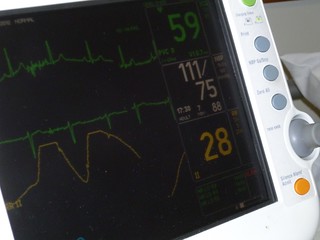
The monitor keeping track of my vital signs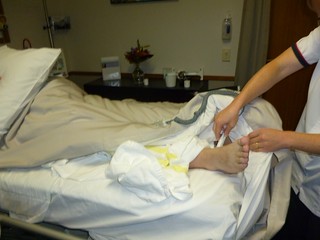
The nursing staff had a little difficulty finding a pulse in my foot, and resorted to ultra-sound
Desiree was solicitous
Dinner was a little problematic, as I was not to use my right-hand, to protect the arterial wound in the wrist
Jayne made the most of the comfortable chair
Subscribe to:
Posts (Atom)
